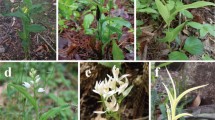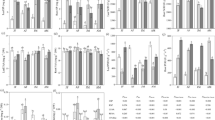Abstract
Carbon autonomy of current-year shoots in flowering, and of current-year shoots plus 1-year-old shoots (1-year-old shoot system) in fruiting of Siberian alder (Alnus hirsuta var. sibirica) was investigated using a stable isotope of carbon, 13C. The current-year shoot and 1-year-old shoot systems were fed 13CO2 and the atom% excess of 13C in flowers and fruits was determined. The majority of photosynthate allocated to flower buds was originally assimilated in the leaves of the flowering current-year shoots. Of all the current-year shoots on fruiting 1-year-old shoots, only those nearest to the fruits allocated the assimilated photosynthate to fruit maturation. These results indicate that the current-year shoots and 1-year-old shoot systems are carbon-autonomous units for producing flowers and maturing fruits, respectively.

Similar content being viewed by others
References
Ashman TL (1994) A dynamic perspective on the physiological cost of reproduction in plants. Am Nat 144:300–316
Bazzaz FA, Carlson RW, Harper JL (1979) Contribution to reproductive effort by photosynthesis of flowers and fruits. Nature 279:554–555
Cliquet JB, Deléens E, Bousser A, Margin M, Lescure JC, Prioul JL, Mariotti A, Morot-Gaudry JF (1989) Estimation of carbon and nitrogen allocation during stalk elongation by 13C and 15N tracing in Zea mays L. Plant Physiol 92:79–87
Cliquet JB, Deléens E, Mariotti A (1990) C and N mobilization from stalk and leaves during kernel filling by 13C and 15N tracing in Zea mays L. Plant Physiol 94:1547–1553
Cooper SD, McGraw JB (1988) Constraints on reproductive potential at the level of the shoot module in three ericaceous shrubs. Funct Ecol 2:97–108
Davis JT, Sparks D (1974) Assimilation and translocation patterns of carbon-14 in the shoot of fruiting pecan trees, Carya illinoensis Koch. J Am Soc Hortic Sci 99:468–480
Deléens E, Cliquet JB, Prioul JL (1994) Use of 13C and 15N plant label near natural abundance for monitoring carbon and nitrogen partitioning. Aust J Plant Physiol 21:133–146
Geiger DR, Swanson CA (1965) Evaluation of selected parameters in a sugar beet translocation system. Plant Physiol 40:942–947
Hansen P (1967) 14C-Studies on apple trees. I. The effect of the fruit on the translocation and distribution of photosynthates. Physiol Plant 20:382–391
Hansen P (1969) 14C-Studies on apple trees. IV. Photosynthate consumption in fruits in relation to the leaf-fruit ratio and to leaf-fruit position. Physiol Plant 22:186–198
Hartt CE (1965) Light and translocation of C14 in detached blades of sugarcane. Plant Physiol 40:718–724
Hartt CE, Kortschak HP, Forbes AJ, Burr GO (1963) Translocation of C14 in sugarcane. Plant Physiol 38:305–318
Hasegawa S, Takeda H (1998) Maturation process of fruits of Japanese alder (Alnus hirsuta var. sibirica) at the level of current shoot (in Japanese with English summary). For Res 70:61–67
Hasegawa S, Takeda H (2001) Functional specialization of current shoots as a reproductive strategy in Japanese alder (Alnus hirsuta var. sibirica). Can J Bot 79:38–48
Haukioja E, Neuvonen S (1985) Induced long-term resistance in birch foliage against defoliators: defensive or incidental? Ecology 66:1303–1308
Haukioja E, Ruohomäki K, Senn J, Suomela J, Walls M (1990) Consequences of herbivory in the mountain birch (Betula pubesens ssp. tortuosa): importance of the functional organization of the tree. Oecologia 82:238–247
Henriksson J (2001) Differential shading of branches or whole trees: survival, growth, and reproduction. Oecologia 126:482–486
Hoffmann AJ, Alliende MC (1984) Interactions in the patterns of vegetative growth and reproduction in woody dioecious plants. Oecologia 61:109–114
Honkanen T, Haukioja E (1994) Why does a branch suffer more after branch-wide than after tree-wide defoliation? OIKOS 71:441–450
Karlsson PS, Olsson L, Hellström K (1996) Trade-offs among investments in different long-shoot functions—variation among mountain birch individuals. J Ecol 84:915–921
Kikuzawa K (1978) Emergence, defoliation and longevity of alder (Alnus hirsuta TURCZ.) leaves in a deciduous hardwood forest stand. Jpn J Ecol 28:299–306
Kozlowski TT (1971) Growth and development of trees. Academic Press, New York
Kozlowski TT, Clausen JJ (1966) Shoot growth characteristics of heterophyllous woody plants, Phaseolus vulgaris L. Can J Bot 44:827–843
Lovett Doust J, Lovett Doust L (1988) Modules of production and reproduction in a dioecious clonal shrub, Rhus typhina. Ecology 69:741–750
Mooney HA (1972) The carbon balance of plants. Annu Rev Ecol Syst 3:315–346
Newell EA (1991) Direct and delayed costs of reproduction in Aesculus californica. J Ecol 79:365–378
Obeso JR (1997) Costs of reproduction in Ilex aquifolium: effects at tree, branch and leaf levels. J Ecol 85:159–166
Rabideau GS, Burr GO (1945) The use of the C13 isotope as a tracer for transport studies in plants. Am J Bot 32:349–356
Reekie EG, Bazzaz FA (1987) Reproductive effort in plants. 1. Carbon allocation to reproduction. Am Nat 129:876–896
Ruohomäki K, Haukioja E, Repka S, Lehtilä K (1997) Leaf value: effects of damage to individual leaves on growth and reproduction of mountain birch shoots. Ecology 78:2105–2117
Sprugel DG, Hinckley TM, Schaap W (1991) The theory and practice of branch autonomy. Annu Rev Ecol Syst 22:309–334
Steer BT, Pearson CJ (1976) Photosynthate translocation in Capsicum annuum. Planta 138:155–162
Stephenson A (1981) Flower and fruit abortion: proximate causes and ultimate functions. Annu Rev Ecol Syst 12:253–279
Takeda F, Ryugo K, Crane JC (1980) Translocation and distribution of 14C-photosynthates in bearing and nonbearing pistachio branches. J Am Soc Hortic Sci 105:642–644
Tuomi J, Niemelä P, Mannila R (1982) Resource allocation on dwarf shoots of birch (Betula pendula): reproduction and leaf growth. New Phytol 91:483–487
Tuomi J, Vuorisalo T, Niemelä P, Haukioja E (1988a) Effects of localized defoliations on female inflorescences in mountain birch, Betula pubescens ssp. tortuosa. Can J Bot 67:334–338
Tuomi J, Vuorisalo T, Niemelä P, Nisula S, Jormalainen V (1988b) Localized effects of branch defoliations on weight gain of female inflorescences in Betula pubescens. OIKOS 51:327–330
Tuomi J, Vuorisalo T, Niemelä P, Haukioja E (1989) Effects of localized defoliations on female inflorescences in mountain birch, Betula pubescens ssp. tortuosa. Can J Bot 67:334–338
Williams K, Koch GW, Mooney HA (1985) The carbon balance of flowers of Diplacus aurantiacus (Scrophulariaceae). Oecologia 66:530–535
Willson MF (1983) Plant reproductive ecology. Wiley, New York
Acknowledgements
We thank T. Ando, K. Kurumado, N. Miyamoto and all the staff of Takayama Research Station, Institute for Basin Ecosystem Studies, Gifu University for their support of field studies. We are grateful to Lake Biwa Museum, Shiga Prefecture for providing facilities for the stable isotope analysis. We are also grateful to H. Barclay and J. Henriksson for reading through the manuscript and giving us valuable suggestions, and to H. Nakajima, M. Hirobe, T. Shirota, M. Takagi, H. Kobayashi, Y. Miyazaki and the members of Laboratory of Forest Ecology, Graduate School of Agriculture, Kyoto University for their advice.
Author information
Authors and Affiliations
Corresponding author
Rights and permissions
About this article
Cite this article
Hasegawa, S., Koba, K., Tayasu, I. et al. Carbon autonomy of reproductive shoots of Siberian alder (Alnus hirsuta var. sibirica). J Plant Res 116, 183–188 (2003). https://doi.org/10.1007/s10265-003-0085-7
Received:
Accepted:
Published:
Issue Date:
DOI: https://doi.org/10.1007/s10265-003-0085-7




